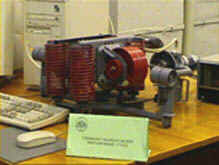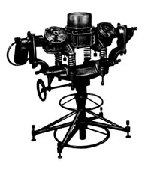|
Leading specialists
Main research areas
Main scientific achivements
Facilities
| |
 |
Joint
Laboratory
of Vibrational Mechanics
of the Institute of the Problems of Mechanical Engineering
and
Institute of Treatment of Mineral Product "Mekhanobr"
Phone: (812) 324 88 12, (812) 321 47 62
Fax: (812) 321 47 71, (812) 325 62 02
new e-mail: blekhman.i.i at gmail.com
|
 |
|
| Head of the laboratory:
I liya I. Blekhman,
Professor, Doctor.of Sci. (Phys.-Math.), member of the
National Committee on Theoretical and Applied Mechanics and of
the National Committee on the Theory of Machines and Mechanisms,
Scientific Boards of the "Mekhanobr" Institute,
St.Petersburg Technical University, Marine Technical University.
The author of more than 150 scientific papers, 2
scientific registered discoveries, 8 books,
40 inventions and patents. Licenses on his inventions have been purchased
by the leading
firms of USA, Japan, Bulgaria, and Iran.
Iliya I. Blekhman is well known as the leading scientist and
engineer in the field of
theoretical and applied mechanics, nonlinear oscillation theory, and vibrational
engineering.
The founder of the theory of vibrational transportation and the theory of the
synchronization
of revolving solids, he discovered and carried out elaborate studies of the phenomena of
self-synchronization of unbalanced rotors.
He has developed the general approaches to the consideration of vibration effects
in nonlinear mechanical systems, the approaches now termed “Vibrational Mechanics”
and “Vibrational Rheology”.
Leading
specialists
Prof. Evgueni B.
Kremer, Doctor of Sc. (Tech.), member of the St. Petersburg Engineering
Academy (Academician Counselor), member of Scientific Board of the
"Mekhanobr" Institute.
The main scientific interests and achievements are connected with the general mechanics,
mechanics of granular materials, hydrodynamics and theory of fracture, specially
with their applications in modeling complicated technological processes
and machines for mineral treatment and other industries dealing with particle
processing,
experience in simulation of mechanical - hydraulic systems for motor vehicles.
The author of more than 120 scientific works and 10
patents.
Prof. Boris P. Lavrov, Doctor of Sc.
(Tech.), member of
Russian Natural Sciences Academy,
member of Scientific Board of the "Mekhanobr" Institute,
the leading experts in the field of the theory and designing of vibratory processes
and machines, the author of more then 150 works including 81
inventions,
co-author of the discovery of the phenomenon of self-synchronization of
unbalanced rotors, awarded Prize of the Government of Russia
for the works in the
field of vibrational technology (1999).
Dr. Leonid I. Blekhman, Ph.D (Tech.),
specialist in the field of theoretical mechanics,
hydrodynamics and the theory of processes and machines.
The main achievements refer to mechanics and hydrodynamics of the rotating
multi-phase
media and modeling technological processes in these media.
He is developing the theory of separating and grinding apparatuses
and of designing the new machines on its base.
He is the author of 20 works, including 9 inventions.
Dr. Vladislav B. Vasilkov, Ph.D (Tech.). Main
scientific interests are associated with
high-velocity interactions of solids and with the theory of cavitation fatigue.
Experience in designing of experimental units for simulation of technology processes and
investigations of the effect of vibration on devices and constructions as well as for
researching the effect of cavitation on different materials.
The author of 61 scientific works and 5 patents.
Dr. Kira S. Yakimova, Ph.D., specialist in the theory of
vibrational processes and
machines and in the theory of processes of mechanical treatment of mineral materials,
author of 35 scientific works and 4 patents. The later
works are connected with the creation
of a new device for separating particles according to their shapes and its application to
grade crushed stones.
Larisa G. Titova, Leading Engineer, specialist in the theory
and simulation of
vibrational processes and machines and in the simulation of mechanical treatment
processes
of mineral materials. A programmer.
The author of 18 scientific works.
Ph. D students:
Alla D. Firsova, M. D.,Graduated
from St. Petersburg Technical University (1999),
Faculty of Physics and Mechanics, Mechanical Engineering Department.
The master thesis was awarded the premium of the St. Petersburg Administration.
Fields of interest: dynamics of rigid bodies, oscillations,
vibrational devices.
Presentations: "Dynamics of axially symmetric solid body
rolling along the cyclic guide",
the XXVIIth International Summer School "Analysis and Synthesis of nonlinear
mechanical
oscillatory systems" (Nonlinear Oscillations in Mechanical Systems 99, NOMS'99),
Repino, St. Petersburg, 1-8 September, Russia, 1999.
Ekaterina V. Shishkina, M. D.,
Graduated from St. Petersburg Technical
University (1999), Faculty of Physics and Mechanics,
Mechanical Engineering Department.
The master thesis was awarded the premium of the St. Petersburg
Administration.
Fields of interest: vibrations(dynamics) of spiral springs,
dynamics of rigid bodies, oscillations, vibrational devices.
Presentations: "Vibrations(dynamics) of spiral springs ",
the XXVIIth International Summer School "Analysis and Synthesis of nonlinear
mechanical oscillatory systems"
(Nonlinear Oscillations in Mechanical Systems 99, NOMS'99),
Repino, St. Petersburg, 1-8 September, Russia, 1999.
Main research areasThe investigation of the effect of vibration on nonlinear
mechanical systems
(vibrational mechanics and vibrational rheology). General approaches, nonlinear
dynamic effects, applications.
Dynamics and strength of machines (crushers, screens, mills, and others).
Mechanics and hydrodynamics of technological processes at the treatment
and
processing of ore.
Vibration-proof insulation and avoiding the harmful vibration.
Development of new techniques for separating crushed stones according to
their shapes.
Cavitation processes and their applications.
Investigations of the phenomenon of appearance of the gravitational
gas-lift streams.
The application of this phenomenon for using new sources of energy from the World Ocean.
The mathematical basis and development of a new approach to forming the
media and
creating materials with preassigned dynamical properties.
Main
scientific achivements
The development of the theory of vibrational
transportation which is the process of
directed “slow” motion caused by “fast” non-directed actions. This theory provides
a basis for designing a number of new vibrational machines (vibrational conveyers,
feeders, screens, concentration tables, crushers, mills, vibro-pumps).
This theory is also successfully applied to develope the technologies for
treatment
of ores (the processes of vibro-flotation, vibro-separation of granular mixtures,
and others).
The discovery of a self-synchronization
phenomenon of unbalanced rotors.
This discovery was registered officially as scientific discovery No 333,
14 May (1987).
The theory of self-synchronization provided a basis for more than 300
inventions
and patents.
The discovery of the phenomenon of appearance
of the gravitational gas-lift stream.
This phenomenon could be the base of new technology, allowing to produce
the inexhaustible energy resources and raw materials of
the World Ocean.
|
| Grants:
|
- Russian Foundation for Fundamental Researches (RFFR) - 1997,
1999, 2000.
- State Grant of Russian Federation for Supporting the Leading Scientific
Schools -
1997, 1998, 1999.
- St.Petersburg Scientific Center. Program "Investigations of the effect of
vibration
on nonlinear mechanical systems to create a new machines and technologies" - 1997.
|
| Facilities: |
The laboratory possesses two unique
vibrational stands for investigations and demonstration
of different effects of mechanics and of vibrational technique.
Some effects that can be investigated and demonstrated
by CB-1
- "Natural" synchronization of rotors at different
relations between their masses and at different directions of their rotations.
- The change of phase shift of synchronous rotation
at self-synchronizations.
- The display of energy transmission via vibrating
organ from one rotor to another in case when one
of the motors is off.
- Zommerfeld's effect.
- The effect of dynamical suppression of oscillations.
Stand CB-1
- The holding of the pendulum in upper unstable position under certain control.
- Different technological effects: vibrational pseudo-liquefaction of granular material,
floatation of "heavy" body in more light medium.
|
| Universal Vibrating Stand |
The stand is designed for studying processes where the
treated material is subjected to
mechanical vibrations of different kinds.The principle of the stand operation is
based
on a pecular physical phenomenon - self-synchronization of mechanical
vibrators,
set on the same working member.
Stand may produce such vibrations that its every point moves through identical
rectilinear,
circular, and elliptical trajectories in any way oriented in space.
It is possible to produce rotary, spiral and other kinds of vibrations too. |
| Technical data Amplitude
of vibrations - up to 10 mm
Frequency of vibrations - about 50 Hz
Max.acceleration
-
50g
Max. mass of model* - 30 kg
Power consumption - 1,2 kW
Weight of the stand - 50 kg
* If the model has its own vibration proof isolators then
its mass can be about 3000 kg |
 |
|
This page was last updated on
03.09.00. |
| Back
|
This page design by Larissa G.Titova
|
